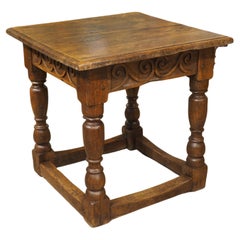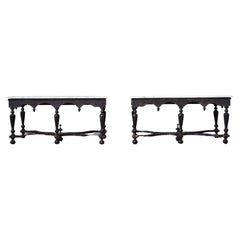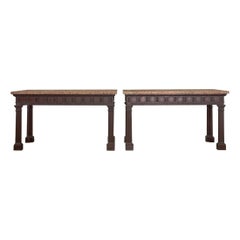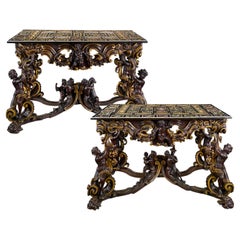18th Century and Earlier Side Tables
to
56
Height
to
Width
to
Depth
to
444
325
784
172
56
50
43
30
11
7
4
4
1
1
1
784
3,253
12,149
12,007
1,509
5,850
2,850
282
89
240
518
379
1,219
1,546
1,405
558
125
744
178
157
153
117
666
277
213
136
105
784
784
784
8
5
1
1
1
Period: 18th Century and Earlier
18th Century English Oak Side or Occasional Table
Located in Dallas, TX
More information coming soon…
Hand-carved in oak during the 1700s, this English side or occasional table would make a wonderful addition to just about any room. The one inch thick ...
Category
English Antique 18th Century and Earlier Side Tables
Materials
Wood, Oak
Pair of William and Mary Side Tables with Carrara Marble Tops
Located in London, GB
An Extremely Rare Pair of William and Mary Side Tables, with original Carrara Marble Tops
Carefully stripped to reveal the scintilla remnants of the original black japanned surface;...
Category
Antique 18th Century and Earlier Side Tables
Materials
Carrara Marble
Price Upon Request
Pair of Late George II Mahogany Side Tables with Original Egyptian ‘Aswan’
Located in London, GB
A Highly Important and Handsomly Drawn Pair of Late George II Mahogany Side Tables with the Original Egyptian ‘Aswan’ Granite Tops in the Manner of Sir William Chambers.
The tables ...
Category
George II Antique 18th Century and Earlier Side Tables
Materials
Mahogany
Grand Ducal Pietre Dure Console Tables
By Andrea Brustolon
Located in New Orleans, LA
Among the most beautiful examples of hardstone artistry that have ever entered our collection, these important Grand Ducal pietre dure console tables are in a class all their own. Their powerful architectural elegance, impressive size and rarity make them two of the finest hardstone masterpieces ever created and quite possibly the greatest pair of pietre dure tables in existence.
With their naturalistically rendered flowers and birds, these tabletop panels showcase the particularly fine quality craftsmanship of the Grand Ducal workshops in Florence during the first quarter of the 17th century. Grand Duke Ferdinando I de Medici, one of the most important personages in the annals of art history, established the Grand Ducal Workshop in 1588. The workshop specialized in the art of pietre dure developed from the ancient art of opus sectile, giving rise to the most luxurious and detailed examples of hardstone artistry ever produced. Its patrons were the Popes and Royals of Europe, and the quality of the objects produced in the workshop is without equal. Typically, because of the high level of workmanship the art form requires, pietre dure plaques were crafted in small sizes. The great majority of known examples of pietre dure are a fraction of the size of our grand tables. The combination of pietre dure and extensive use of other rare decorative hardstones such as lapis lazuli and pietra paesina or “ruin marble” meant that these tabletops were surely produced for a wealthy collector.
The tables are further distinguished by their superbly carved bases by Andrea Brustolon, known as the “Michelangelo of wood.” Brustolon was a Venetian wood sculptor known for his exuberant and intricate Baroque furniture. His high Baroque style was influenced by his years studying in Rome, where he was exposed to the sculpture of Gian Lorenzo Bernini. Crafted in the early 18th century, these bases display Brusolon’s unmatched talent for both figural and foliate work, combining cupids, masks and oversized scrolling vines for a grand, ornate effect. Similar furnishings by Brustolon are held in museums worldwide, including the Victoria & Albert Museum, the National Museum of Scotland and the Metropolitan Museum of Art, while the Ca' Rezzonico Museum in Venice features an entire room dedicated to the sculptor.
For approximately 150 years, these tables were part of the famed Stoneleigh Abbey collection owned by the Lord Leigh family. This renowned English country estate inspired Jane Austen to write Mansfield Park. Lord Leigh eventually sold the tables at Christie’s London in 1962, and the pair have stayed in the collection of the same Florentine family who purchased them from Christie's until we recently acquired them.
Our tables are prominently pictured in the important Saul Levy book Il Mobile Veneziano del Settencento. The pietre dure plaques date circa 1625-1650. The decorative tops likely would have originally been sold with a pair of plain stone columns to display them, and Lord Leigh would have commissioned the custom bases from Brustolon circa 1714 when he added the impressive four-story fifteen-bay Baroque West Wing to Stoneleigh Abbey.
A similar single Grand Ducal tabletop is in the United Kingdom’s National Trust Collection, and a smaller tabletop resides in Buckingham Palace. The flower and bird panels in our examples relate to the famous Badminton Cabinet...
Category
Italian Baroque Antique 18th Century and Earlier Side Tables
Materials
Wood
Price Upon Request
Read More
In Guadalajara, These Luscious Side Tables Are Chiseled from Volcanic Rock
Use them as tables or stools, indoors or out.
Christopher Norman Is Turning the Cast-Off Urban Trees of Los Angeles into Art
With a World War II–era milling machine, the California artist crafts poetic, sculptural furniture pieces.



